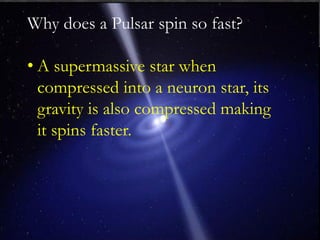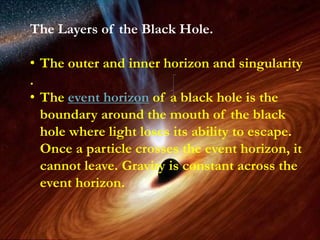Pulsars and black hole
- 3. are rotating/ spinning neutron stars discovered in late 1967 by graduate student Jocelyn Bell Burnell and Anthony Hewish as radio sources that blink on and off at a constant frequency initially referred to as LGM1, now called PSR B1919+21 Like a ship in the ocean that sees only regular flashes of light, we see pulsars "turn on and off" as the beam sweeps over the Earth.
- 4. How do they form? • It is a remnant of supernova explosion. • Hence, they were known to us as the neutron star, specifically “rotating neutron star”.
- 5. What Makes it Pulse? • pulsars appear to pulse because they rotate! • we see pulsars "turn on and off" as the beam sweeps over the Earth.
- 6. Why does a Pulsar spin so fast? • A supermassive star when compressed into a neuron star, its gravity is also compressed making it spins faster.
- 7. How dense are Pulsars? • Pulsars are very dense. • Its mass is 4 to 8 times greater than the sun.
- 8. What makes them light? • They undergo the process called accretion. • they grabs on electron to other atomic fields and flings them into space in high speed emitting radiation. • This form is called the beam of light.
- 9. How do we classify pulsars? • They can be classified into two; • spin-powered pulsars- indicates that the source of energy is from the rotation of the neutron star. • accretion-powered pulsars- the source of energy came from the accumulated material around the neutron star.
- 10. How about the types of Pulsar? Those with periods of a few milliseconds and whose periods are changing very slowly are called the millisecond pulsars. The remainder are simply called the "ordinary pulsars".
- 11. How was the Pulse interval of the Pulsar? • The time interval between consecutive pulses is called the pulsar's period.
- 12. • It is observed that the highest frequencies of a pulse arrive at a telescope slightly before the lower frequencies. • Due to intersellar medium. • Its pulse will also weakens as time passes by or they may already undetectable.
- 13. Can we actually see Pulsars through our naked eyes? No! they are discovered using optical, X-ray and gamma-ray telescopes. Parkes radio telescope (the star of the film "The Dish"). The enormous Arecibo radio telescope in Puerto Rico, the Green Bank telescopes in America, the Molonglo telescope in Australia and the Jodrell Bank telescope in England.
- 14. Why would it be undetectable? • Pulsars either stay at one place or may transfer from one place to another. • The fastest pulsar can escape to a galaxy and will never come back.
- 15. Do Pulsars orbit? • Yes they do! Some Pulsars came in pair some are loner. • When they come in pair or in binary system, the pulsar will orbit its pair or the other way around.
- 16. How about the structure of the Pulsar?
- 17. The interior structure of a neutron star consists of iron, neutron rich nuclei and electrons in the outer crust. The inner crust contains neutron rich nuclei, free superfluid neutrons and electrons and the interior, superfluid neutrons, superfluid protons and electrons. The makeup of the core is unknown.
- 18. So what have we learnt? The observations of pulsars tell us that: • they are far away • they are very small • they are very dense • they can orbit other objects • they were probably born in supernova explosions • they are travelling very fast through space • the time between pulses is extremely regular although they are slowing down very slightly.
- 19. Black Hole
- 20. What is a Black Hole? • a place in space where gravity pulls so much that even light can not get out • They are invisible • has extreme density • Albert Einstein first predicted black holes in 1916 with his general theory of relativity. • The term "black hole" was coined in 1967 by American astronomer John Wheeler, and the first one was discovered in 1971.
- 21. How Do Black Holes Form? Stellar black holes form when the center of a very massive star collapses in upon itself. This collapse also causes a supernova, or an exploding star, that blasts part of the star into space. Scientists think supermassive black holes formed at the same time as the galaxy they are in.
- 22. How Big Are Black Holes? • Black holes can be big or small • The smallest can be the size of the atom with a mass equal to a mountain. • The biggest can be the size of few million earth with a mass equal to 1 million sun together.
- 23. If Black Holes Are "Black," How Do Scientists Know They Are There? • Scientists can study stars to find out if they are flying around, or orbiting, a black hole. • When a black hole and a star are close together, high-energy light is made
- 24. Could a Black Hole Destroy Earth? • Earth will not fall into a black hole because no black hole is close enough to the solar system for Earth to do that.
- 25. What are the three types of a black hole? 1.Stellar black holes — small but deadly. They are formed when a star more than three times the mass of the sun collapsed. 2.Intermediate Black Hole- formed when stars in a cluster collide in a chain reaction.
- 26. 3.Supermassive black holes — the birth of giants, are millions or even billions of times as massive as the sun, but have a radius similar to that of Earth's closest star. Such black holes are thought to lie at the center of pretty much every galaxy, including the Milky Way.
- 27. The Layers of the Black Hole. • The outer and inner horizon and singularity . • The event horizon of a black hole is the boundary around the mouth of the black hole where light loses its ability to escape. Once a particle crosses the event horizon, it cannot leave. Gravity is constant across the event horizon.
- 28. • The inner region of a black hole, where its mass lies, is known as its singularity, the single point in space-time where the mass of the black hole is concentrated.
- 29. References: Redd, N. T. (2015, April 09). Black Holes: Facts, Theory & Definition. Retrieved July 08, 2016, from http://www.space.com/15421-black- holes-facts- formation-discovery- sdcmp.html May, S. (Ed.). (2015, September 08). What Is a Black Hole? Retrieved July 08, 2016, from http://www.nasa.gov/audience/forstudents/k- 4/stories/nasa-knows/what-is-a-black-hole-k4.html
- 30. End*** Prepared by: Jaytell-boy N. Ursua, IV BSE1 English





























